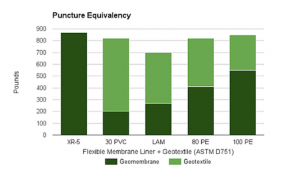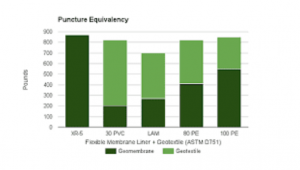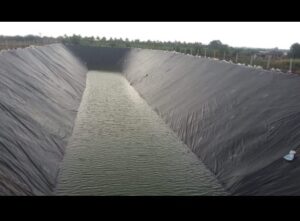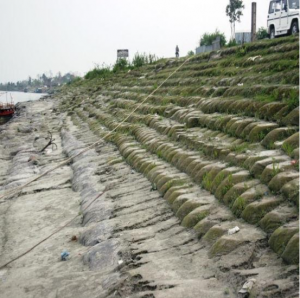How Much Does Geomembrane Cost?


When describing a geomembrane, it’s easy to lose sight of the overall picture. There are many aspects to consider when selecting the greatest match for your application, but the lifetime cost is sometimes disregarded.
A geomembrane with a low starting cost may end up costing you just as much, if not more, as one with a higher initial cost. Before writing the check, investigate the true cost of the geomembrane by looking at typical costs spent during the product’s lifetime.
Costs of a Geomembrane at the Start
The distinctions between high-density polyethylene (HDPE) and ethylene interpolymer alloy (EIA) geomembranes (such XR-5® Geomembranes) are discussed in this article to demonstrate the point. The geomembrane cost breakdown categories will be same regardless of the items you’re comparing.
Material expenses, installation fees, and the cost of building quality assurance are the three primary components of initial expenditures (CQA). Although material prices have a significant influence on the lifespan cost of your geomembrane, for less costly materials, labour will consume a significant chunk, if not the whole amount of capital. A chart outlining some important changes may be seen below.
It’s worth noting that the above EIA material prices include both shipping and manufacture. The costs given in this table for both geomembranes are estimates that may vary depending on the size of the project. Larger tasks, for example, will have cheaper per-square-foot material and fabrication costs. Prices for HDPE tend to vary on a regular basis, so be sure to contact the relevant manufacturer when putting together your own pricing comparison. Because there are considerably fewer field seams, the cost of flexible/fabricated geomembranes will be substantially cheaper.
The cost of adding a geotextile to a geomembrane is shown in the final part of the pricing breakdown. Because EIA geomembranes offer better puncture resistance (over 800 pounds of ball tip puncture resistance), they may be utilised without a geotextile in many cases, as seen in the table below. Other geomembranes on the market, on the other hand, do not have that luxury and require extra materials to achieve the same degree of puncture strength, resulting in additional geomembrane expenditures to the entire installation price.
During this phase, the average longevity should also be considered. A geomembrane with a proven track record of over 30 years may be more expensive up front, but the return on investment will be higher than a geomembrane with a lower initial cost but a shorter lifespan of 10 to 15 years.
Repairability & Maintenance

In order for your geomembrane to continue working at its optimum, it must be maintained on a regular basis. However, the quantity of maintenance required varies from one geomembrane to the next. Some geomembranes, such as HDPE, suffer from environmental stress cracking (ESC), whilst others, such as EIA, are designed with low thermal expansion qualities, making them more dimensionally stable. ESC may happen at any point over the life of your geomembrane, which means you may need to replace it fully before receiving a return on your investment.
Finally, you should not choose a geomembrane merely on the basis of its initial cost. Extra costs will sneak up on you, resulting in a higher total cost over time. Make sure you do your homework and analyse your alternatives before settling on a product that meets both your performance and financial needs.
In order for your geomembrane to continue working at its optimum, it must be maintained on a regular basis. However, the quantity of maintenance required varies from one geomembrane to the next. Some geomembranes, such as HDPE, suffer from environmental stress cracking (ESC), whilst others, such as EIA, are designed with low thermal expansion qualities, making them more dimensionally stable. ESC may happen at any point over the life of your geomembrane, which means you may need to replace it fully before receiving a return on your investment.
Finally, you should not choose a geomembrane merely on the basis of its initial cost. Extra costs will sneak up on you, resulting in a higher total cost over time. Make sure you do your homework and analyse your alternatives before settling on a product that meets both your performance and financial needs.
Costs of a Geomembrane at the Start
The distinctions between high-density polyethylene (HDPE) and ethylene interpolymer alloy (EIA) geomembranes (such XR-5® Geomembranes) are discussed in this article to demonstrate the point. The geomembrane cost breakdown categories will be same regardless of the items you’re comparing.
Material expenses, installation fees, and the cost of building quality assurance are the three primary components of initial expenditures (CQA). Although material prices have a significant influence on the lifespan cost of your geomembrane, for less costly materials, labour will consume a significant chunk, if not the whole amount of capital.
The Initial Costs of Geomembrane
To highlight the concept, this article compares and contrasts high-density polyethylene (HDPE) and ethylene interpolymer alloy (EIA) geomembranes (such as XR-5® Geomembranes). Regardless of the things you’re comparing, the geomembrane cost breakdown categories will be the same.
The three key components of early expenditures are material costs, installation fees, and the cost of constructing quality assurance (CQA). Although material costs have a considerable impact on your geomembrane’s lifetime cost, for less expensive materials, labour will consume a large portion, if not the whole amount of capital. Below is a graph that highlights several significant changes.
It’s important to note that the EIA material prices shown above include both shipping and manufacturing. The pricing for both geomembranes listed in this table are estimates that may vary depending on the scope of the project. Larger projects, for example, will have lower material and manufacturing costs per square foot. Prices for HDPE tend to fluctuate on a regular basis, so when putting together your own pricing comparison, be sure to contact the relevant manufacturer. Flexible/fabricated geomembranes will be far less expensive since there will be many fewer field seams.
In the last section of the pricing breakdown, the cost of adding a geotextile to a geomembrane is shown. Because EIA geomembranes have a higher puncture resistance (over 800 pounds of ball tip puncture resistance), they may be used in many situations without a geotextile, as shown in the table below. Other geomembranes on the market, on the other hand, lack this luxury and require additional materials to attain the same level of puncture resistance, resulting in higher geomembrane costs added to the overall installation cost.
The typical lifespan should also be addressed at this time. A geomembrane with a 30-year track record may be more expensive up front, but the return on investment will be greater than a geomembrane with a lower initial cost but a 10- to 15-year lifetime.
Repairability and upkeep
Your geomembrane must be serviced on a regular basis in order to continue operating at its best. The amount of care required, however, varies from one geomembrane to the next. Some geomembranes, such as HDPE, are prone to environmental stress cracking (ESC), whilst others, such as EIA, are engineered to have limited thermal expansion, making them more dimensionally stable. ESC can occur at any time over the life of your geomembrane, which means you may need to completely replace it before seeing a return on your investment.
Finally, don’t pick a geomembrane only on the basis of its original price. Extra charges will accumulate over time, resulting in a larger final cost. Before selecting on a product that fulfils both your performance and financial demands, make sure you do your homework and compare your options.
Your geomembrane must be serviced on a regular basis in order to continue operating at its best. The amount of care required, however, varies from one geomembrane to the next. Some geomembranes, such as HDPE, are prone to environmental stress cracking (ESC), whilst others, such as EIA, are engineered to have limited thermal expansion, making them more dimensionally stable. ESC can occur at any time over the life of your geomembrane, which means you may need to completely replace it before seeing a return on your investment.
Finally, don’t pick a geomembrane only on the basis of its original price. Extra charges will accumulate over time, resulting in a larger final cost. Before selecting on a product that fulfils both your performance and financial demands, make sure you do your homework and compare your options.
FAQs
Can geomembranes be used in decorative or landscaping applications?
Yes, geomembranes can be used for decorative purposes, such as lining ponds or water features in landscaping projects, as they provide a reliable water barrier.
What is the expected installation time for a geomembrane liner?
The installation time for a geomembrane liner depends on the size of the project, site conditions, and the experience of the installation crew. It can range from a few days to several weeks.
Are geomembranes resistant to root penetration?
Most geomembranes are resistant to root penetration. However, additional measures such as root barriers or geotextiles can be used to provide extra protection.
Can geomembranes be used in mining applications?
Yes, geomembranes are widely used in mining applications such as heap leach pads, tailings ponds, and containment for acid mine drainage.
What is the function of a leak detection system in geomembrane installations?
A leak detection system monitors the integrity of a geomembrane liner by detecting leaks or breaches and triggering alarms or notifications for prompt repair.
How are geomembranes protected during construction activities?
Geomembranes are typically protected during construction by covering them with geotextiles, geogrids, or protective layers to prevent damage from equipment, sharp objects, or abrasion.



